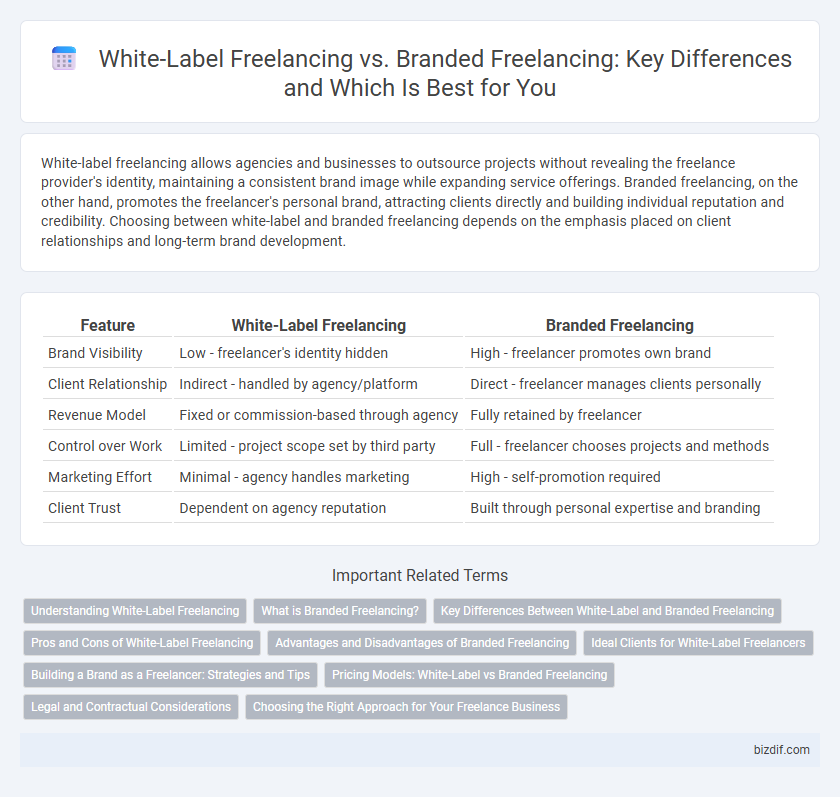White-label freelancing allows agencies and businesses to outsource projects without revealing the freelance provider's identity, maintaining a consistent brand image while expanding service offerings. Branded freelancing, on the other hand, promotes the freelancer's personal brand, attracting clients directly and building individual reputation and credibility. Choosing between white-label and branded freelancing depends on the emphasis placed on client relationships and long-term brand development.
Table of Comparison
| Feature | White-Label Freelancing | Branded Freelancing |
|---|---|---|
| Brand Visibility | Low - freelancer's identity hidden | High - freelancer promotes own brand |
| Client Relationship | Indirect - handled by agency/platform | Direct - freelancer manages clients personally |
| Revenue Model | Fixed or commission-based through agency | Fully retained by freelancer |
| Control over Work | Limited - project scope set by third party | Full - freelancer chooses projects and methods |
| Marketing Effort | Minimal - agency handles marketing | High - self-promotion required |
| Client Trust | Dependent on agency reputation | Built through personal expertise and branding |
Understanding White-Label Freelancing
White-label freelancing involves delivering services that are rebranded and sold by another company, allowing freelancers to work behind the scenes without direct client interaction. This model offers scalability and consistent workflow by partnering with agencies or businesses that handle client relations and branding. Understanding white-label freelancing can help professionals leverage their skills while maintaining anonymity and focusing solely on project execution.
What is Branded Freelancing?
Branded freelancing involves building and promoting a unique personal or business brand that differentiates your services in the freelance marketplace. This approach prioritizes establishing a recognizable identity, often through a custom logo, consistent messaging, and targeted marketing strategies that attract loyal clients. Branded freelancers typically leverage their reputation and professional image to command premium rates and long-term projects.
Key Differences Between White-Label and Branded Freelancing
White-label freelancing involves delivering services under another company's brand, allowing freelancers to remain anonymous while the client manages customer relationships. In branded freelancing, freelancers promote their own personal or business brand, directly building client trust and reputation through transparent service delivery. The key differences lie in brand ownership, client interaction, and marketing control, with white-label focusing on backend service provision and branded freelancing emphasizing personal or business brand development.
Pros and Cons of White-Label Freelancing
White-label freelancing allows professionals to provide services under a third party's brand, offering benefits like expanded client reach and reduced marketing efforts. However, it presents challenges such as limited brand recognition, dependence on the contracting company's reputation, and reduced control over project presentation. While it enables freelancers to focus on delivering quality work, potential income caps and lack of direct client relationships can impact long-term growth.
Advantages and Disadvantages of Branded Freelancing
Branded freelancing offers the advantage of building a personal or business reputation, fostering client trust and recognition which can lead to higher rates and loyal clientele. It allows freelancers to showcase their unique skills and create a distinct market identity, enhancing long-term career growth and professional networking opportunities. However, branded freelancing requires significant time and effort to maintain brand consistency, manage marketing, and handle client expectations, which can be challenging without a team or additional resources.
Ideal Clients for White-Label Freelancers
White-label freelancers are ideal for agencies and businesses seeking scalable, behind-the-scenes support without exposing external contractors to their clients. These clients prioritize confidentiality, consistent quality, and seamless integration into their existing workflows. Companies needing specialized skills without the overhead of full-time hires often turn to white-label freelancers to maintain brand integrity and client trust.
Building a Brand as a Freelancer: Strategies and Tips
Building a strong personal brand as a freelancer involves establishing a unique identity that reflects your skills, values, and expertise, which sets you apart from white-label freelancing where services are delivered under another company's name. Developing a consistent visual identity, crafting a compelling portfolio, and leveraging social media platforms are key strategies to attract direct clients and increase visibility. Focusing on client relationships and collecting testimonials further enhances credibility and long-term success in branded freelancing.
Pricing Models: White-Label vs Branded Freelancing
White-label freelancing often employs fixed or volume-based pricing models, allowing agencies to resell services under their own brand without markup complexities. Branded freelancing typically uses value-based or hourly pricing, reflecting the freelancer's established reputation and personal brand equity. Agencies opting for white-label solutions benefit from predictable costs, while branded freelancers leverage premium pricing tied to their expertise and direct client relationships.
Legal and Contractual Considerations
White-label freelancing involves delivering services under another company's brand, requiring clear contractual clauses on intellectual property rights, confidentiality, and non-compete agreements to protect both parties. Branded freelancing necessitates agreements that affirm the freelancer's ownership of work, allowing clients limited usage rights while safeguarding the freelancer's portfolio and trademarks. Legal considerations in both models should address liability, payment terms, and dispute resolution mechanisms to ensure compliance and minimize risks.
Choosing the Right Approach for Your Freelance Business
White-label freelancing offers the advantage of scalability by allowing freelancers to work under another brand, enabling access to larger projects and diverse client bases without building brand recognition. Branded freelancing emphasizes personal brand development, fostering direct client relationships and higher profit margins through unique expertise and reputation. Selecting the right approach depends on your long-term goals, desired client engagement, and capacity for marketing and brand management.
white-label freelancing vs branded freelancing Infographic

 bizdif.com
bizdif.com